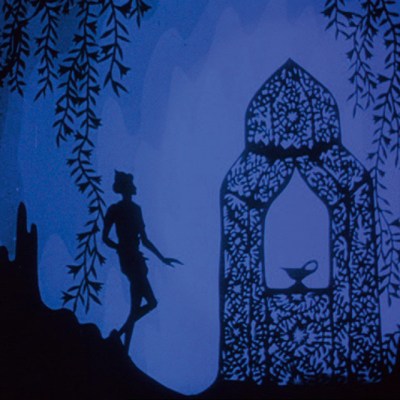Two children draw close to a boy-showman’s magic lantern, fascinated by the delights within. Produced by Sèvres in 1757, Étienne-Maurice Falconet’s biscuit porcelain group illustrates the latest development of the camera obscura, but also of the decorative arts: Europeans had discovered the secret of porcelain mere decades earlier. At the Wallace Collection, it is juxtaposed with a black-and-white film from 1931, showing two Meissen-esque figures dancing to Mozart. The Clock Store is an early short by a 20th-century purveyor of the magic lantern who, like Sèvres, was constantly testing the limits of technology: ‘Inspiring Walt Disney’ runs from these ‘Silly Symphonies’ of the early 1930s to the studios’ first experiments with CGI in the late ’80s.
Bracket clock (c. 1739), attributed to Jacques Gouchon (movement maker). The Wallace Collection

Displaying previously unseen studio drawings, storyboards and concept art alongside rococo furniture, Sèvres porcelain, Boulle clocks and Meissonnier candelabras, this exhibition argues for the synergies between Disney studio productions and the French 18th-century decorative arts so well represented in the Wallace Collection. Though it draws from across the Disney canon, it focuses on two films based on 18th-century sources: Cinderella (1950), originally by Charles Perrault (1697), and Beauty and the Beast (1991), by Gabrielle-Suzanne Barbot de Villeneuve (1740). In one direction, the conceit is natural. Walt Disney was fascinated with Europe, and magpie-like in his references. The queen in Snow White is lifted from a statue of the Margravine of Meissen in Naumburg Cathedral, while Sleeping Beauty (1959) draws on illuminations. In the 1930s, he began collecting rare books, including editions of Perrault illustrated in 18th-century dress by Félix Lorioux and Edmund Dulac, to form a reference library for the studio.
Concept art for Beauty and the Beast (1991), Peter J. Hall. © Disney

What is more surprising is how well the comparison works the other way. The 18th century is primed for animation. There are allegorical heads in the clocks and animal feet in the furniture. The pennant on a ship-shaped Sèvres pot-pourri vase from the early 1760s seems to flap in the wind and rear up against its porcelain waves, while the stags’ legs on a writing table attributed to Bernard I van Risenburgh are a witty counterpoint to the transformation of Actaeon on its marquetry surface. The metamorphoses go beyond the visual: in 1742, Claude Prosper Jolyot de Crébillon’s sensational satirical novel The Sofa told of a courtier condemned to inhabit various pieces of upholstered furniture. The period was also preoccupied by one of ‘Uncle Walt’s’ personal obsessions. Five years after the making of Falconet’s The Magic Lantern, with its chubby ‘Enfants Boucher’, Jean-Jacques Rosseau’s Émile; Or, On Education (1762), declared that the child, though ‘good as it leaves the hands of the Author of things […] degenerates in the hands of man’. In a distant echo of Rousseau in 1938, Disney pronounced that his films were designed neither for ‘grown-ups’ nor for children, but for ‘that fine, clean, unspoiled spot down deep in every one of us, that maybe the world has made us forget’.
Concept art for Beauty and the Beast (1991), Brian McEntee. © Disney

Practically, the juxtaposition shows that studios work in similar ways; with teams striving for visual coherence in both cases. Women, notably Louis XV’s mistress, Madame de Pompadour, were crucial patrons of Sèvres and initially also played an important part in its manufacture, painting porcelain as part of the ‘floristry’, until they were banned from the factory in 1753. In Disney’s male-dominated studios, women were relegated to the ink and paint department, but the colourist Mary Blair and storyboard artist Bianca Majolie nonetheless played key roles in the development of Cinderella (Blair would stay with Disney until Peter Pan in 1953; Majolie was fired in 1940). Indeed, at times, the rococo seems to have challenged the rigid heteronormativity of the Disney studios. Jean Gillmore’s concept art for the villainous Gaston, in Beauty and the Beast, imagines him as a pink profusion of frogging, lace and periwig, some distance from the American ideal of the 1980s. Though, as ultimately realised, Gaston remains a camp caricature, his hypermasculine costume and physique are less evocative of the rococo than the neoclassical figures of Jacques-Louis David – who similarly considered the femininity of the rococo tantamount to degeneracy. Indeed, though many of Disney’s concept sketches begin with the rococo of the 1700s, the final films ultimately tend to draw on the rococo’s 19th-century revival. Cinderella takes its cue from the Second Empire, a visual world much simpler to animate – and incidentally more amenable to Walt Disney’s vision of all-American heterosexuality.
Vase with the head of an elephant (1757), designed by Jean Claude Chambellan Duplessis the Elder and painted by Charles-Nicolas Dodin for Sèvres. The Wallace Collection, London

Today, Disney interest in the French rococo apparently remains unabated. Since at least the 1980s, various animators – many working in a temporary London outpost in Goodge Street – have spent time with Jean-Honoré Fragonard’s The Swing (c. 1767), now newly cleaned. After abortive attempts to weave it into Beauty and the Beast and Tangled (2010), the picture achieved its cameo in 2013, in Frozen. For these artists, the fascination of Fragonard’s painting was its depiction of movement and its proliferation of possible viewpoints, two ideas unlikely to occur immediately to the art historian. One of the joys of an exhibition paying such tribute to the rococo’s exuberance is this invitation to new ways of looking.
‘Inspiring Walt Disney: The Animation of French Decorative Arts’ is at the Wallace Collection, London, until 16 October.



